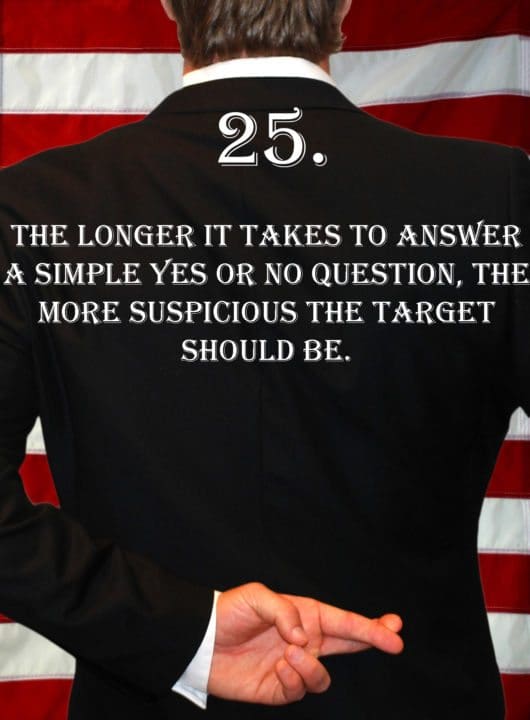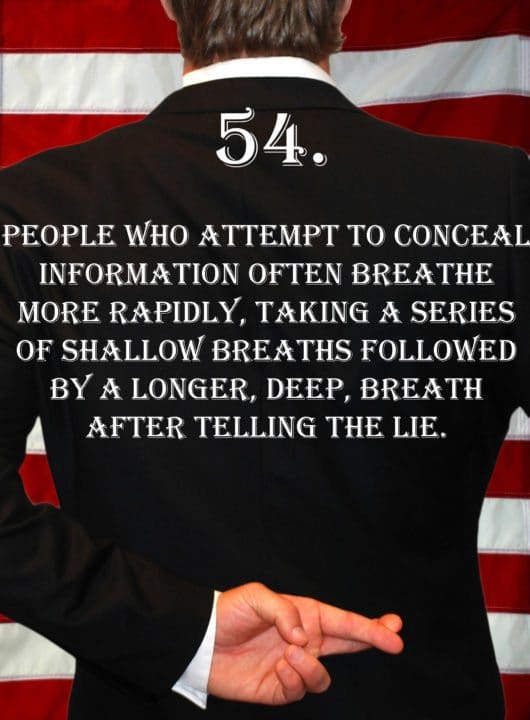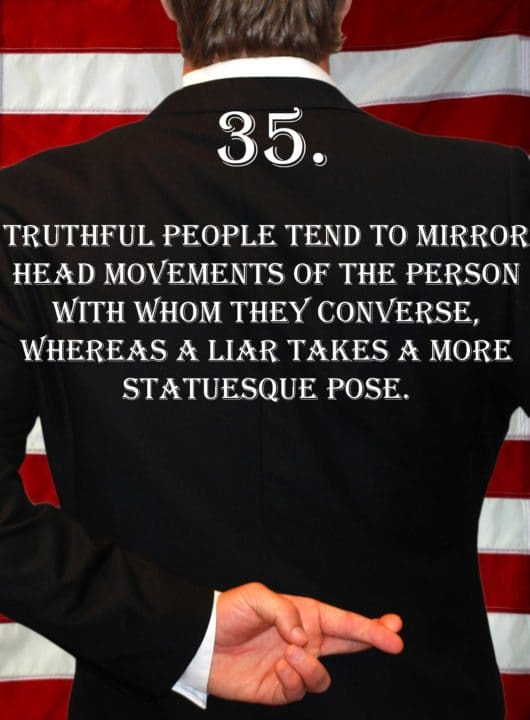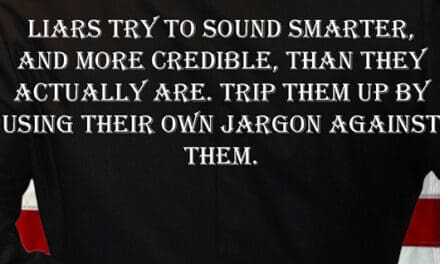
Deception Tip 25:
The longer it takes to answer a simple yes or no question, the more suspicious the target should be.
Listen To The Podcast!
E25 – Yes Or No – Deception Tips Podcast – Click Here To Subscribe
Podcast Transcript
Hello and welcome to the deception tips podcast where you will learn amazing cues to detect deceit that will help you read people like never before. I’m your host Spencer Coffman. Let’s get started.
Welcome back to the deception tips podcast. This is Episode 25, thanks for tuning in. Last week, we talked about some symmetrically in expressions. We also spoke of truthfulness and pledging truthfulness. People often overemphasize or over pledge the truth.
Hopefully, you’ve had some chances to interact with other people and it would be really cool if you have noticed someone using one of these intro statements such as ‘to be honest’ or ‘I’m not going to lie’ or ‘to tell you the truth’ etc.
Because if you’ve noticed that, it means that what you heard last week has taken root and taken effect in your life and you are starting to become more aware of your surroundings and more aware of what other people are saying and doing because of listening to this episode, or this podcast series really.
And that is excellent because that is why I do this. That is why these episodes are made, they’re made for you so that you can learn more about body language and behavior, and never be lied to again.
Obviously, you’ll be lied to, but you will not fall for these lies if you can spot the truth and spot this deception, which is the sole purpose. Because we can be trained, we can train ourselves to see deception and to spot lies.
It’s just a question of whether or not we will allow ourselves to be trained and to see those deception signs and those lies. Because a lot of people are very happy in their little world of fantasy or being lied to. Ignorance is bliss and a lot of people love bliss. That’s not you or you wouldn’t be listening to this episode or the series.
So, today we are going to talk about something that we’ve kind of talked about before. It is a sign that is more of the strategy side or the verbal side. It’s when a liar is talking, and you notice something in their response. Now, we talked about this when we spoke of quick answers of ‘yes’ or ‘no’. This was back in episode 10.
We’ve also hinted at it throughout the last episodes and the series and how like with rehearsed stories and staying silent. Episodes 15 and 13 where we spoke of that, because, oftentimes, liars use statements or use words to help themselves think more or ponder what they’re going to say or to rehearse it one last time before they let it out or let you hear what they’re saying. Because they need to make sure it sounds good. They want to make sure that they are convinced of the lie.
As we’ve said numerous times, I probably said it in the past eight episodes in a row, consecutively. I mean, I say this a lot that liars are also trying to convince themselves of the lie as much as they are trying to convince the target of a lie.
So, if they say something to delay, and the thing we talked about last time with pledging your truthfulness with someone says ‘to be honest’ that could be a delayed statement to give them more time to think. They could say, “you know, to be honest, I do blah, blah blah”.
So, that could give them some more time to think about what they’re going to say or to think about their lie. Or, “I’m not going to lie, but this would be a great color to choose to paint your wall”, was a delayed statement. Really, what they should say is “you know what goes with this color”, done, simple, easy.
And this was the same with the delayed answers or the quick answers that are, conversely, the same type of deal. People give delayed, people give quick. Quick answers of ‘yes’ or ‘no’, back in episode 10, is like if you ask someone a question and they say yes, and then boom they go into an explanation, that could happen instantly. Or, they could say delayed like the yes and then you know that alright, what’s coming up? However, what or but what? And they continue on with an explanation.
As we’ve said before, the best answers to ‘yes’ or ‘no’ questions are ‘yes’ or ‘no’. And this is especially true in detecting deception or when you are asking someone a question. One of my favorite responses is when people are taking a little bit too long to respond or when they start talking too much, cut them off.
It’s not an essay question, it’s a ‘yes’ or ‘no’ question. So, it’s not an essay question, they just need a ‘yes’ or ‘no’ response. The best answer to a ‘yes’ or ‘no’ question is by definition ‘yes’ or ‘no’, which means if people answer with anything else something’s up.
Either they need to over-explain something because they’re worried that you’re going to think something about them or they’re lying or whatever the case may be. But always keep that in mind, the best answer to a ‘yes’ or ‘no’ question is ‘yes’ or ‘no’.
So today here is Episode Twenty-five. The longer it takes to answer a simple ‘yes’ or ‘no’ question, the more suspicious the target should be. Here it is again, deception tip twenty-five, the longer it takes to answer a simple ‘yes’ or ‘no’ question, the more suspicious the target should be.
Now, this is very important because when you ask someone a ‘yes’ or ‘no’ question, again it’s simple, it’s really not that hard. “Did you go to work today?” “Yes”, “no”. “Are you listening to the deception tips podcast right now?” Yes”, “no”. The answer is yes. “Are you listening to Episode 20 of the deception tips podcast now?” Well, you may have to think about that one unless you don’t know. But this is Episode Twenty-five, so the answer is no.
I mean, if you have to look at your phone or something to determine what episode this is then that could have taken a little bit of time to respond. But you were actively pursuing the response. You weren’t thinking of something to come up with.
When people lie, they oftentimes delay that. So, if I ask you a ‘yes’ or ‘no’ question, “did you go to work today?” and you stop and think about it, wait a minute, what is there to think about? You either did or you didn’t, it’s that simple.
Yet a lot of people, especially when people tell lies or when they’re trying to get out of something or pass the blame or whatever the case may be, or if they’re worried about what you might think of them, so they want to explain it or think about how they’re going to explain it, that is the key right there, they want to think about it.
So, when they delay their response, they are trying to think about something, and they are planning their story. They’re thinking about what they’re going to say, how they’re going to say it, they may be even thinking about how you’re going to react and what they’re going to do. They’re oftentimes pondering in their minds.
A lot of times we see people, they usually think about what they’re going to say next instead of listening to what you’re saying. That’s the case with probably 90 percent of the people I talked to. They’re talking and then when I start talking now, they’re not even listening to me, they’re thinking about what they’re going to say next.
And then I may even pose a question and bam they just go right into what they’re saying. It’s like, wait a minute were you not even listening? Good grief, why do I bother talking to you? And you notice that too, I’m sure, in a lot of your conversations. And some people just don’t listen.
But we’re going to talk a lot more about the ‘yes’ and the ‘no’s’ and simple answers and delayed responses and some of the deception stuff that could happen within that right after this.
Are you loving this podcast? Spencer Coffman has created some deception tip videos to help you keep the wool off your eyes. Subscribe to the body language channel on YouTube today.
Deception is a huge thing when it comes to ‘yes’ or ‘no’ questions. People either answer right away with ‘yes’ or ‘no’ to get the lie over with or they answer slowly with a ‘yes’ or ‘no’ and then wait a little bit so they can think about the response, like a delaying attempt to give them more time to think.
Or they don’t say anything and then say ‘yes’ or ‘no’ and then continue their response. So, they’re delaying somewhere, either they’re truthful and they answer right away, they’re lying and they answer right away, or they’re truthful and they delay, or they’re lying and they delay.
Now, whether they delay before they say ‘yes’ or ‘no’ or after they say ‘yes’ or ‘no’ is, however, they decide to respond. But the point is, they can either be truthful or lying in any of these situations. However, if it sounds unnatural, it’s most likely to be a lie. What’s natural and what’s unnatural?
Think about it like last time when I gave you the example “to be honest with you I’d paint the wall blue”. Well, that sounds natural until I point out how silly it is by saying, “OK, to be honest with you”. So, yesterday when you told me whatever you weren’t being honest, because today you said you’re going, to be honest. It sounds silly or I’m not going to lie, again silly.
So, if you point these out that’s how you know. So, think about the responses of ‘yes’ or ‘no’ and how they are in each of these scenarios. They are either immediate responses of ‘yes’ or ‘no’, they’re either a delayed response of ‘yes’ or ‘no’ followed by an explanation or it’s an instant response of ‘yes’ or ‘no’ with a delayed explanation.
Think about the logic in each of them followed by what comes next and with the question that you asked. Did the question you asked need some type of thought? Like, for example, are you listening to Episode 20 of the deception tips podcast?
Well, if you don’t immediately know that this is Episode Twenty-Five, you may need a little bit of time to look at your phone and see whether or not it’s episode twenty or twenty-five or what before you answer, which could mean there’s a delay. Now, does that delay mean you are being deceptive? No, you just didn’t know the answer, so you had to look it up or find it.
Or maybe you don’t remember the answer, so you have to think about it and then say ‘yes’ or ‘no’ and whatever explanation you may have along with it. Or maybe I ask you, “is this episode 20?” and you say, “no”. Then you say, “wait a minute I need to check” and then that’s your explanation. “Oh, wait a minute I checked” or maybe you say, “yes, oh wait a minute I guess it’s not. I just looked at my phone it’s episode twenty-five, I’m sorry”.
So that would be an explanation after a ‘yes’ or ‘no’ question. However, the explanation was a correction and thereby was the truth. So, you lied unknowingly then you corrected it with the truth that you knew after checking.
So, there are a number of different examples but keep in mind that ‘yes’ or ‘no’ questions are very easy and very simple to answer. So, if you operate under the motive and the operational theory that ‘yes’ or ‘no’ questions should always be answered with a ‘yes’ or ‘no’ and they are very easy to answer, then anything that deviates from that pattern you need to look at a little bit more closely.
And then you need to determine whether or not the deviation from that pattern was truthful because there is a legitimate explanation or false or lying because they needed more time to think about and plan their responses.
And whether or not they needed more time to think about it and plan it to be able to convince themselves or to be able to convince others of that deception is something that you’ll have to figure out within there and you’ll have to base that figuring on clusters and patterns of behavior that you will observe within that interaction.
So, if they say ‘yes’ and then delay and then the explanation, pay attention to that explanation and see if there are any other signs of deception. Because if that explanation is a lie, then there are going to be more signs of deception within that explanation because they’re lying.
So, they’re going to be displaying several different signs of leakage. And if you know what those are, which you should know several of them by now, you should be able to pick up on them.
And also, pay very close attention to yourself. Notice how you respond to yes or no questions. Oftentimes we can learn the most about body language through being self-aware. Our self-awareness will teach us so much.
You’ll notice yourself doing certain things standing in certain ways, doing certain hand gestures, and saying certain things because you are made aware of it. You will start to notice it more and you can determine whether or not you were telling the truth or a lie or why you may have said that because this is different for everybody. One guy could fold his arms and he’s cold and another guy could fold his arms and he’s defensive, it could happen differently.
A great example that I’ve always loved is, if you take 10 people put them in a room one by one with a brown chair then have them all write down an explanation of the brown chair, you will have 10 completely different explanations.
Why? Everybody experiences things differently, everybody goes through things differently. So, the reason you may say ‘yes’ or ‘no’ in a certain way and the reason someone else may say ‘yes’ or ‘no’ in a certain way does not always mean that they are lying. That part is not universal.
What’s universal, is the behaviors and the patterns that go with those statements and those clusters. So, there could be multiple interpretations of these signs, yet that’s why you need to look at multiple signs because multiple facts don’t lie, it’s like evidence.
When evidence starts piling up, OK, we got him on this, we got him on this, we got him on this, we got 20 different things. Well, that’s a pretty solid case against that person, so they pretty much did it. Or well, that evidence is circumstantial, OK well, then they’re going to get off with it.
When there are multiple signs of deception you have a better indicator and more certainty that that person is being deceptive. So, watch out for multiple signs, be self-aware and think about when you say some of these things, ‘yes’ or ‘no’, whether it’s immediate, whether you have an explanation, whether it’s a delayed response, etc.
And think about, in your own experience, when you say that, analyze it, evaluate it, think about what you’re thinking, think about what you were going through at that moment. Why did you answer in a certain way? And then apply that to other people’s situations when you’re observing and see if maybe some of those self-awareness thoughts would apply to their situations and help you to determine whether or not that person is telling the truth. The main thing to remember is that the best answer for a ‘yes’ or ‘no’ question is always ‘yes’ or ‘no’.
I want to thank you for listening to the deception tips podcast. I encourage you to share with your friends. Subscribe to the feed check out the deception tips blog and take a look at the books I have available. And as always tune in next week for a new deception tip.
Video Transcript
Hey guys, my name is Spencer Coffman. Thank you for watching the Deception Tips Videos, they are all about teaching you how to read people and detect deception so that you will be able to tell if someone is lying to you.
Today we are going to talk about a cool thing that we’ve kind of hit it on a lot of times before, and it’s really the simplest answer is “yes or no.” It’s very, very simple. If you ask a yes or no question, the answer should be yes or no. Anytime it is not, then something else could be going on. It’s not an essay question, so this is up to you, the target, or the person trying to find the truth to ask the right questions. Ask questions that are easily answerable. Ask yes or no questions when needed. Other times you may need to ask narrative questions to get more of their story, so you have a chance to see more leakage happen, but whenever you ask a yes or no question, the easiest answer is always yes or no.
So here it is, this is Deception Tip number 25: The longer it takes to answer a simple yes or no question, the more suspicious the target should be.
Now, this is important because it’s, the longer it takes to answer, notice I said a simple yes or no question. Now, any question that is a yes or no question is pretty simple. Did you go to work today? Yes or no. That’s it. It’s very simple. What are you, are you wearing a black suit coat today? It’s very simple, is it yes or no? Is your shirt white? Is it yes or no? It’s very easy. There’s no explanation needed, there’s no ifs, ands, or buts about it. It’s yes or no.
Now, if it takes a long time for them to answer that yes or no question, then you need to be suspicious of that. Now, be careful, because in Video Number 10, or episode number 10, or whatever number 10 you’ve listened to, whether it’s been a podcast, a blog post or one of these videos, we’ve talked about quick answers of yes or no. So if they, you ask a yes or no question, and they give you a quick answer of yes or no, that could be good.
However, if they lengthen it, or add a description or some kind of an explanation onto that, or if they give you that answer right away, but prolonging an answer, such as like a “yessss” type of a thing, then even though they got back to you right away, they’re adding an explanation and in reality, a yes or no question shouldn’t need an explanation if you ask the question properly.
Are you wearing a black suit coat today? My answer would be yes. Done. Simple. And then, if you followed up with why, well, then I could come up with an explanation as to why. But the first question did not need the explanation. So anytime someone adds an explanation out of that, now that could be cause for suspicion. In addition, if it takes them a long time to answer this yes or no question, that could be cause for suspicion as well.
Now, why should it make you suspicious? Well, because the answer to the question is very simple. They shouldn’t need to think about it. It’s yes or no. They’re very, very easy, and if you ask the questions and, and they’re very simple like that, then why would they need to explain? They shouldn’t feel the need that they need to justify their answer, or they need to do anything further than that. Did you show up for work yesterday? You say yes or no. Now, really what happens is people feel the need that they need to come up with an excuse or justify it.
So, for example, did you show up for work yesterday? If you didn’t or were you late for work yesterday, that would maybe be a more applicable one. You might say “yes, but I was late because my son was sick, or my daughter was sick, or I got in a car accident,” or whatever.
Well really the answer was yes, you were late. And if the boss or whoever’s asking cares to know why, they may say, “do you have an excuse?” Or, “do you have an explanation?” Or, “was there a good reason?” Then you could come up with a reason. Now, in that case, it’s not really a lying situation, but still, that’s probably no doubt happened to you, that you’ve felt the need to justify your answer, and that’s where this is coming from, from a lying perspective.
Liars often want to justify their lie. And they don’t really want to do it tor the target’s sake, they’re doing it for themselves. They’re not only trying to convince the target of the lie, but they’re also trying to convince themselves of the lie. So by saying yes or no, and then adding an explanation on it, they’re convincing themselves of the lie. In the meantime, they’re also trying to convince the target of the lie. But what they don’t realize is that this should make the target way more suspicious because they’re using a yes or no question as an essay question, which does not need to happen.
So if that’s happening, look for some other signs, because they will also be leaking on the body. Because if there’s trying to explain their lie, that means they’re getting more nervous, they’re getting tense, they have something that they need to let out, so there will be a ton of other body language signs that you should be able to pick up on.
If this is your first time watching these videos, I would love to have you subscribe to the channel on YouTube. Also, feel free to leave any comments down there as well. In addition, if you’d like some more information, we’ve got books, podcasts, blog posts, all available on SpencerCoffman.com that are 100% dedicated to teaching you exactly what every body is saying.
Until next time.






